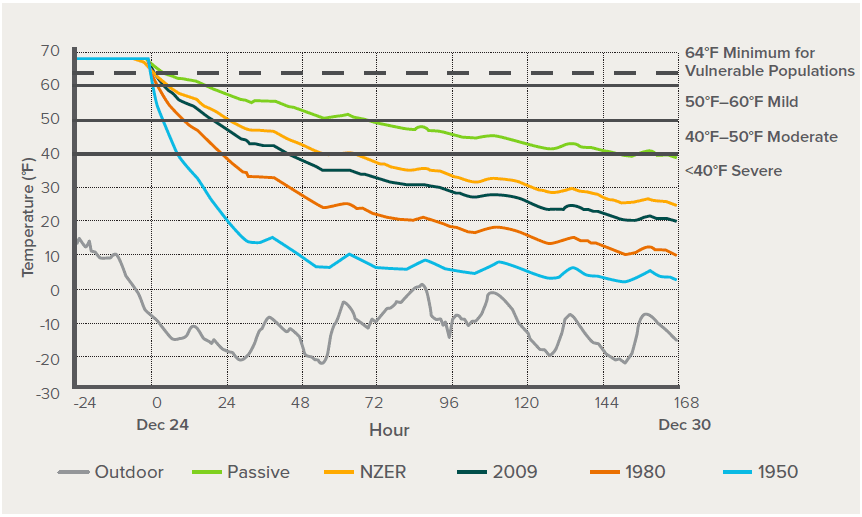
Resilient, Carbon-Free Buildings Are Within Reach
We must build to weather the storm and fight climate change too. By integrating resilience and decarbonization, we can create safer and more sustainable spaces for the future.
In the last few years, communities across the United States have increasingly faced climate-driven hardship — from extreme cold in Texas, to heat waves and wildfires nationwide, to the devastating Hurricanes Helene and Milton earlier this month. While these extreme weather events alone are concerning, the power outages that follow have also become longer and more frequent, endangering lives even after the weather has calmed.
These outages are being driven by a combination of aging electric and gas infrastructure, overwhelming demand during extreme temperatures, and weather-related disruption. In July 2024, more than a million Texas households were left sweltering in summer heat without power after Hurricane Beryl damaged swaths of electrical infrastructure. It has also become increasingly clear that these extreme events and outages hit highly vulnerable populations the hardest, including low-income households, Black and Hispanic households, the elderly, and those with health conditions.
To keep all occupants comfortable, safe, and healthy in the buildings they live, work, and play in, we must improve the ability of our buildings to resist and recover quickly from disruption.
We need to better coordinate building decarbonization and resilience efforts
Despite the risks of more frequent and severe climate events and resulting power outages, resilience is often undervalued and isolated from building decarbonization efforts, and vice versa. There is an opportunity to avoid these silos and reinforce the complementary benefits between them. First, because building construction and operations are responsible for 35 percent of total US greenhouse gas emissions, it is a critical sector to decarbonize to make US and global climate goals achievable. And second, because buildings need significant resilience investment to recover from and prepare for extreme climate events, we can encourage “opportunistic decarbonization” to proactively select climate-friendly electric equipment and sustainable materials. Further, because resilient buildings better withstand extreme events, they offer improved longevity and durability of equipment and materials, saving home and building owners from future costs. This ultimately reduces the planet-heating emissions associated with the building’s lifecycle, known as embodied carbon.
Better yet, we can further align these efforts to achieve both building decarbonization and resilience goals at the same time. This is possible by implementing two pillars of “passive” and “active” measures to reduce our vulnerability to extreme events and increase our capacity to handle disruption, all while transitioning buildings away from fossil fuels.
Passive measures are a valuable first priority
While both pillars of passive and active measures benefit resilience and decarbonization, passive measures are the first priority to address two main challenges: 1) peak energy load management and 2) energy affordability and equity.
Electrification in the building, transportation, and industrial sectors is projected to dramatically increase peak electricity demand. Prioritizing passive measures helps manage the total electricity load growth. For example, according to RMI research (Hu et al. 2024), peak electricity demand in New York State could rise by 123 percent by 2050 if residential buildings are simply electrified. However, implementing residential envelope retrofits combined with building electrification would reduce this peak electricity demand growth by 27 percent. Moreover, passive measures are already widely implemented and prioritized in decarbonization efforts to reduce energy use and carbon emissions. RMI's founder, Amory Lovins, highlights that equipping buildings with passive measures can eliminate, shrink, or simplify HVAC equipment when electrified.
Another challenge is energy affordability and equity, which is recognized as an essential priority in both national and state level building decarbonization efforts. Prioritizing passive measures such as weatherization drives down total energy usage and lowers utility costs year-round. It also reduces the size of solar PV and battery storage to meet a building’s remaining energy needs and provide back-up power when necessary. Because passive measures can reduce total load and shift load outside of the hours of peak demand on the grid, it helps empower buildings as grid resources that support reliability.
Each of these benefits is especially valuable for households in environmental justice communities that may financially struggle to purchase and use heating and cooling equipment to maintain safe indoor conditions during extreme events. Notably, RMI research has demonstrated that passive measures significantly extend a homes’ “hours of safety” during an outage shown below. Improving passive measures in new buildings to meet or exceed current energy code is often cost-effective, and in existing buildings can extend the ability to shelter in place by as much as 120 percent during extreme cold and up to 140 percent during extreme heat. However, passive measures have been adopted more slowly than the rate needed to confront climate threats. Quantifying the resilience benefits of passive measures could be beneficial to accelerate the adoption of passive measures.

Building Performance in Simulated Power Outage (begins 12/24); Passive: Passive House, NZER: Net Zero Energy Ready Homes
Three real-world examples demonstrate the value of breaking down silos
Using this integrated approach to decarbonization and resilience, we can steward climate progress and prepare for future climate threats like flooding, extreme temperatures, and wildfires.
While there will be challenges ahead, proactive efforts toward this goal will deliver benefits to households and businesses, their broader communities, and the climate. To spark this change, we need to foster deeper coordination and collaboration between building decarbonization and resilience practitioners, develop improved metrics and assessment tools to inform market and policy decision-making, and ensure everyone has access to incentives that put these upgrades within reach.
To learn more, check out our report on Hours of Safety and the new Resilient Solutions Web Hub.
Reference
Hu X., B. Webster, M. Huang. 2024. The Value of Building Envelope Retrofits in a Deeply Decarbonized New York State. ASHRAE Annual Conference, 22-26 June 2024, Indianapolis, IN. ASHRAE, 2024. https://events.rdmobile.com/Lists/Details/2320163